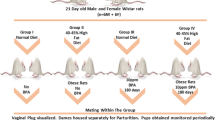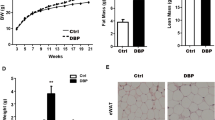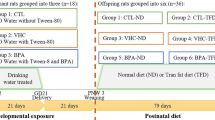Abstract
We reported that perinatal exposure to bisphenol A (BPA) resulted in obesity in offspring female rats, and down-regulated zinc-alpha2-glycoprotein (ZAG) mRNA expression in subcutaneous adipose tissue maybe was associated with increased body weight in previous study. Considering that the mechanism of ZAG actions has not been clear, and ZAG gene expression levels are different with adipose tissues, we investigate the levels of ZAG mRNA and protein expression in visceral (perigonadal and perirenal) adipose tissue, and the mechanism of ZAG increasing body weight in BPA exposed rats. Pregnant rats were exposed to BPA in water at levels of either 1 μg/mL(low dose of BPA, LBPA) or 10 μg/mL (high dose of BPA, HBPA) from gestation day 6 to the end of lactation. ZAG mRNA and protein expression from visceral adipose tissue of offspring female rats on postnatal day 50 (PND50) were measured. The levels of fatty acid synthase (FAS) and hormone-sensitive lipase (HSL) gene expression, and peroxisome proliferator-activated receptors-γ (PPARγ) mRNA and protein in visceral adipose tissue were also determined. There was large size of adipocytes in perigonadal adipose tissues in BPA treated offspring female rats. Perinatal exposure to BPA could decrease the levels of ZAG and PPARγ mRNA and protein expression in visceral adipose tissues, and increase FAS gene expression, but decrease HSL gene expression. These findings indicated that BPA exposure during early development results in large size of adipocytes, which was associated with down-regulated ZAG gene. Low expression of ZAG gene increased lipogenesis and decreased lipolysis, which was associated with down-regulated PPARγ gene induced by BPA.
Similar content being viewed by others
References
Newbold, R. R., Padilla-Banks, E. & Jefferson, W. N. Environmental estrogens and obesity. Mol Cell Endocrinol 304:84–89 (2009).
Bhandari, R., Xiao, J. & Shankar, A. Urinary Bisphenol A and Obesity in US Children. Am J Epidemiol 177:1263–1270 (2013).
Alonso-Magdalena, P. et al. Bisphenol A exposure during pregnancy disrupts glucose homeostasis in mothers and adult male offspring. Environ Health Perspect 118:1243–1250 (2010).
Groff, T. Bisphenol A: invisible pollution. Current Opinion in Pediatrics 22:524–529 (2010).
Zhang, L., Zhang, H. Y., Ma, C. C., Zhai, L. L. & Jia, L. H. Effect of bisphenol A exposure during early development on glucose metabolism and adipokine expression in adolescent female rats. Mol Cell Toxicol 9:385–391 (2013).
Bing, C., Mracek, T., Gao, D. & Trayhurn, P. Zinca2-glycoprotein: an adipokine modulator of body fat mass? Int J Obes 34:1559–1565 (2010).
Tzanavari, T., Bing, C. & Trayhurn, P. Postnatal expression of zinc-a2-glycoprotein in rat white and brown adipose tissue. Molecular and Cellular Endocrinology 279:26–33 (2007).
Bing, C. & Trayhurn, P. New insights into adipose tissue atrophy in cancer cachexia. Proc Nutr Soc 68: 385–392 (2009).
Gong, F.Y. et al. Zinc-alpha2-glycoprotein is involved in regulation of body weight through inhibition of lipogenic enzymes in adipose tissue. J Clin Endocrinol Metab 94:4499–4507 (2009).
Chmielewska-Kassassir, M., Woźniak, L. A., Ogrodniczek, P. & Wójcik, M. The role of peroxisome proliferator-activated receptors ? (PPAR?) in obesity and insulin resistance. Postepy Hig Med Dosw 67:1283–1299 (2013).
Sarafidis, P. A. & Lasaridis, A. N. Actions of peroxisome proliferator-activated receptors-gamma agonists explaining a possible blood pressure-lowering effect. Am J Hypertens 19:646–653 (2006).
Evans, R. M., Barish, G. D. & Wang, Y. X. PPARs and the complex journey to obesity. Nat Med 10:355–361 (2004).
Bao, Y. et al. Zinc-alpha2-glycoprotein, a lipid mobilizing factor, is expressed and secreted by human (SGBS) adipocytes. FEBS Lett 579:41–47 (2005).
Vom Saal, F. S. & Myers, J. P. Bisphenol A risk and metabolic disorders. JAMA 300:1353–1355 (2008).
Somm, E. et al. Perinatal exposure to bisphenol A alters early adipogenesis in the rat. Environ Health Perspect 117:1549–1555 (2009).
Author information
Authors and Affiliations
Corresponding author
Rights and permissions
About this article
Cite this article
Zhang, L., Zhang, H.Y., Ma, C.C. et al. Increased body weight induced by perinatal exposure to bisphenol A was associated with down-regulation zinc-alpha2-glycoprotein expression in offspring female rats. Mol. Cell. Toxicol. 10, 207–213 (2014). https://doi.org/10.1007/s13273-014-0022-y
Received:
Accepted:
Published:
Issue Date:
DOI: https://doi.org/10.1007/s13273-014-0022-y




